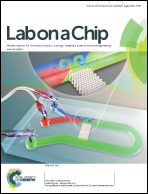Fabrication of 3D high aspect ratio PDMS microfluidic networks with a hybrid stamp†
Abstract
We report a novel methodology for fabricating large-area, multilayer, thin-film, high aspect ratio, 3D microfluidic structures with through-layer vias and open channels that can be bonded between hard substrates. It is realized by utilizing a hybrid stamp with a thin plastic sheet embedded underneath a PDMS surface. This hybrid stamp solves an important edge protrusion issue during PDMS molding while maintaining necessary stamp elasticity to ensure the removal of PDMS residues at through-layer regions. Removing edge protrusion is a significant progress toward fabricating 3D structures since high aspect ratio PDMS structures with flat interfaces can be realized to facilitate multilayer stacking and bonding to hard substrates. Our method also allows for the fabrication of 3D deformable channels, which can lead to profound applications in electrokinetics, optofluidics, inertial microfluidics, and other fields where the shape of the channel cross section plays a key role in device physics. To demonstrate, as an example, we have fabricated a microfluidic channel by sandwiching two 20 μm wide, 80 μm tall PDMS membranes between two featureless ITO glass substrates. By applying electrical bias to the two ITO substrates and pressure to deform the thin membrane sidewalls, strong electric field enhancement can be generated in the center of a channel to enable 3D sheathless dielectrophoretic focusing of biological objects including mammalian cells and bacteria at a flow speed up to 14 cm s−1.


 Please wait while we load your content...
Please wait while we load your content...